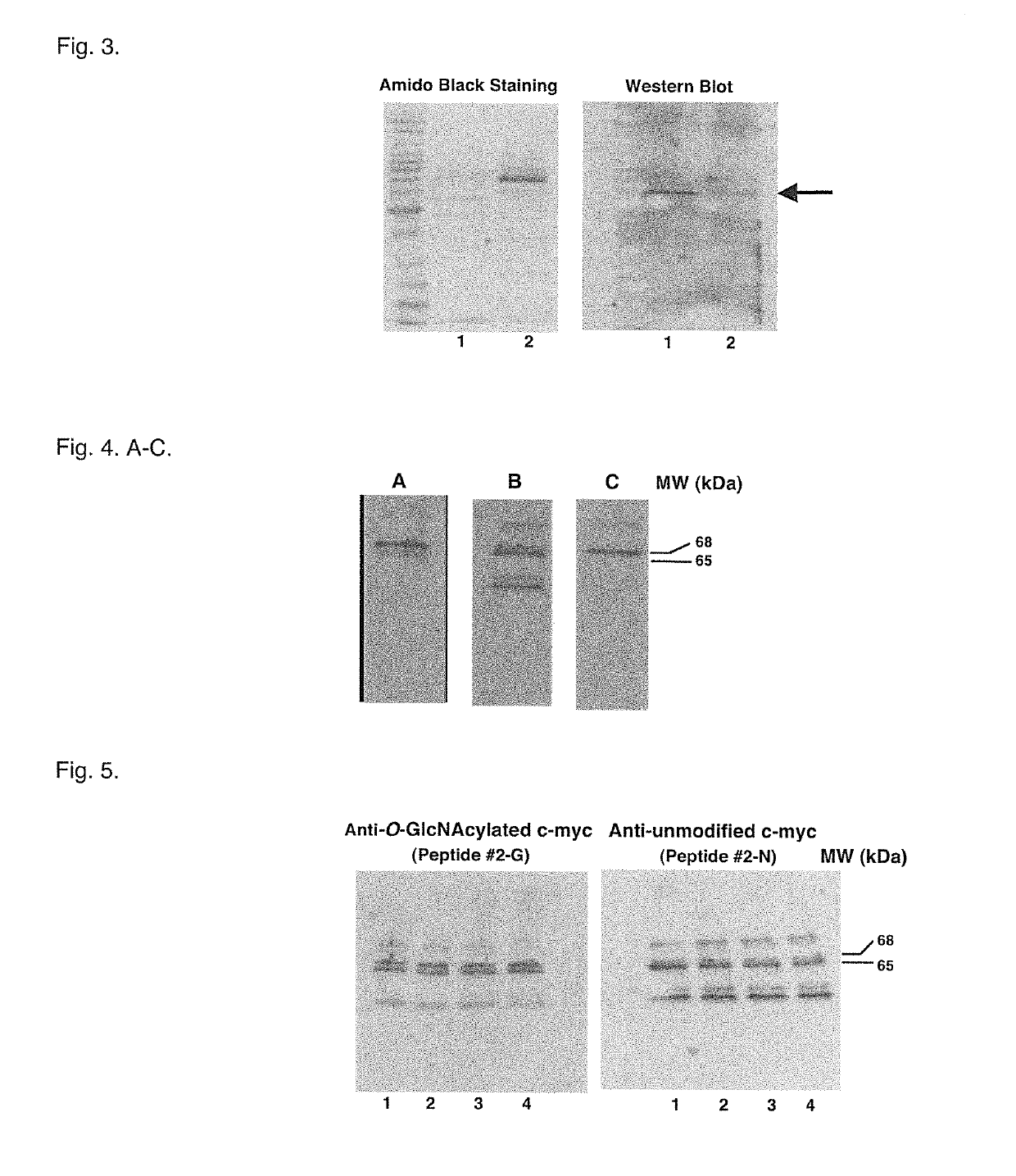Glycosylation site-specific antibodies and anti-cancer compounds
a site-specific antibody and anti-cancer technology, applied in the field of characterization of site-specific antibodies for oglcnacylated proteins, can solve the problem that the method cannot identify only the inhibitors of glcnacase, and achieve the effects of increasing the oglcnacylation of c-myc or oglcnacylation of p53, enhancing the oglcnacylation of c-myc and p53
- Summary
- Abstract
- Description
- Claims
- Application Information
AI Technical Summary
Benefits of technology
Problems solved by technology
Method used
Image
Examples
example 1
Characterization of Sensitivity of Site-Specific Anti-Peptide Antibodies for O-GlcNAcylated and Corresponding Unmodified p53 and c-Myc Proteins
[0066]Antibody titers were measured with 5,000- through 1,000,000-fold diluted immune sera using ELISA plates coated with free BSA and O-GlcNAcylated and unmodified c-myc or p53 peptides conjugated to BSA (1 μg / well).
[0067]Whereas anti-sera for Ser-149 O-GlcNAcylated (Peptide #1-G) and unmodified (Peptide #1-N) p53 showed almost no cross-reactivity (optical density at 450 nm: 0) with BSA, the immune sera showed very high cross-reactivity (optical density at 450 nm: 3.4 and 3.6, respectively, with 10,000-fold dilution) (FIG. 1, Panel A). Titers (dilution factor at 50% of maximum OD) of the p53 anti-sera were 135,000 and 98,000, respectively.
[0068]Whereas anti-sera for Thr-48 O-GlcNAcylated (Peptide #2-0) and unmodified (Peptide #2-N) c-myc showed almost no cross-reactivity (optical density at 450 nm: 0) with BSA, the immune sera showed very hi...
example 2
Characterization of Specificity of Site-Specific Antibodies for O-GlcNAcylated and Corresponding Unmodified p53 and c-Myc Proteins
[0070]To determine the specificity of the antibodies for O-GlcNAcylated and corresponding unmodified p53 and c-myc proteins, Western blot analysis was carried out with BSA (2 μg / lane) and O-GlcNAcylated and unmodified p53 and c-myc antigen peptides conjugated to BSA (0.2 μg / lane, 10 times less than the BSA, a negative control).
[0071]Specificity of the antibodies was determined by Western blot analysis with BSA conjugated with O-GlcNAcylated and unmodified c-myc and p53 peptides (FIG. 2A). BSA negative controls were produced by simultaneously carrying out conjugations with the EDC or sulfo-SMCC methods but without addition of peptides. Western blot analyses of BSA and BSA conjugated with O-GlcNAcylated and corresponding unmodified c-myc peptides (Peptide #2-0 and #2-N) were carried out using c-myc antibodies. c-Myc antibodies for the O-GlcNAcylated peptide...
example 3
Evidence that the Anti-Peptide Antibodies are O-GlcNAcylation Site-Specific for Ser-149 of p53 and Thr-58 of c-Myc Proteins
[0072]Specificity of the antibodies for O-GlcNAcylated p53 and c-myc proteins was further determined using O-GlcNAcylated p53 and c-myc antigen peptides. Western blot analysis was carried out with BSA (2 μg / lane) and O-GlcNAcylated p53 (Peptide #1-G) and c-myc (Peptide #2-0) antigen peptides conjugated to BSA (0.2 μg / lane, 10 times less than the BSA, a negative control) with antibodies for O-GlcNAcylated p53 and c-myc proteins (FIG. 2B).
[0073]Thr-58 O-GlcNAcylation site-specific c-myc antibodies did not cross-react with O-GlcNAcylated p53 peptides, and Ser-149 O-GlcNAcylation site-specific p53 antibodies did not cross-react with O-GlcNAcylated c-myc peptides (FIG. 2B). This result demonstrated that the O-GlcNAcylation site-specific c-myc and p53 antibodies recognize specifically the Thr-58 and Ser-149 O-GlcNAcylation sites of c-myc and p53, respectively, which a...
PUM
| Property | Measurement | Unit |
|---|---|---|
| pH | aaaaa | aaaaa |
| stability | aaaaa | aaaaa |
| fluorescent | aaaaa | aaaaa |
Abstract
Description
Claims
Application Information
 Login to View More
Login to View More - R&D
- Intellectual Property
- Life Sciences
- Materials
- Tech Scout
- Unparalleled Data Quality
- Higher Quality Content
- 60% Fewer Hallucinations
Browse by: Latest US Patents, China's latest patents, Technical Efficacy Thesaurus, Application Domain, Technology Topic, Popular Technical Reports.
© 2025 PatSnap. All rights reserved.Legal|Privacy policy|Modern Slavery Act Transparency Statement|Sitemap|About US| Contact US: help@patsnap.com



